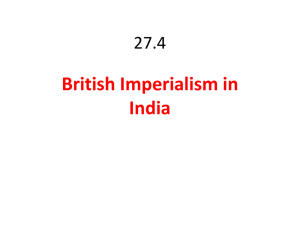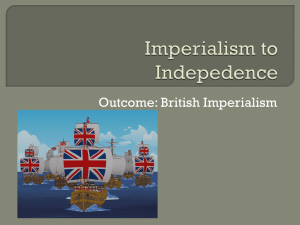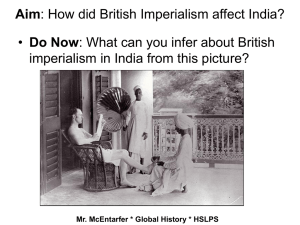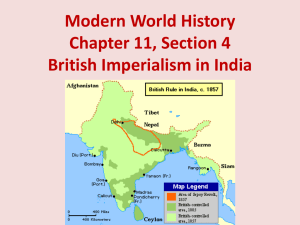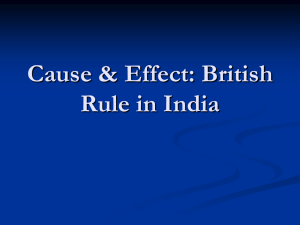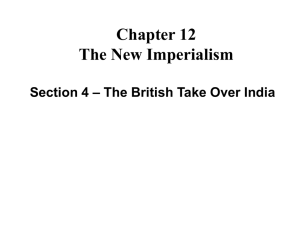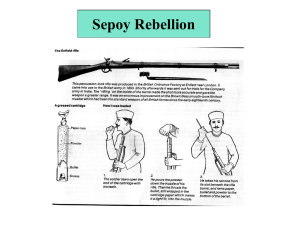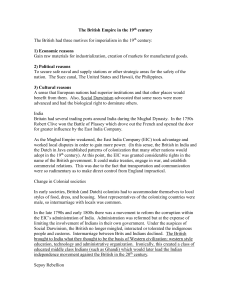British Take Over India
advertisement
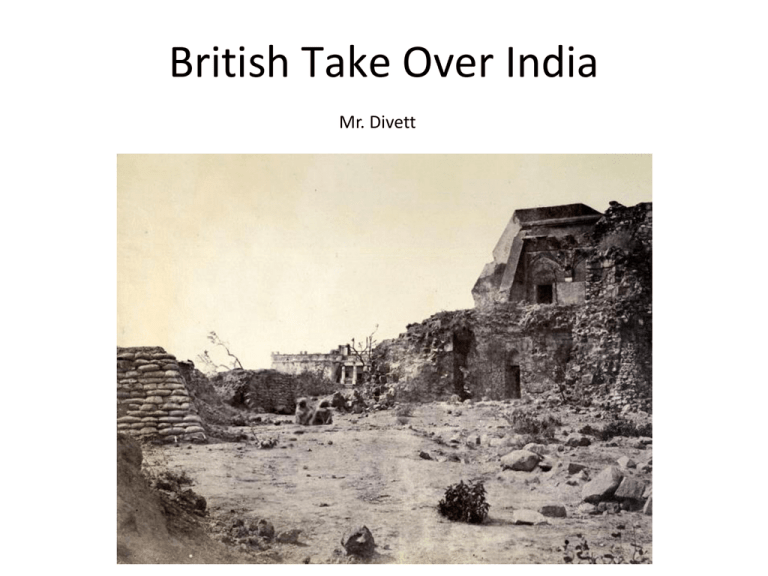
British Take Over India Mr. Divett Collapse of the Mughal empire • • The Mughal empire had ruled India for 200 years. After they started to collapse Britain started to take interest in the region. East India Company and Rebellion • • The British East India Company won trading rights in the early 1600s. By the mid 1800s they controlled three fifths of India. East India Company Exploiting Indian Diversity • • • The British took advantage of the diversity. The disunified Indian people couldn’t not unite against the newcomers. British used superior weapons to overpower local rulers. Implementing British Policies • Profit was primary goal of EIC. • They also: • – Improved roads – Preserved peace – Reduced banditry By the early 1800s British officials introduced: – Western education – Legal procedures Western Education Implementing British Policies • • Missionaries tried to convert Indians to Christianity. The British press social change. They work to: – End slavery – End the caste system – Improve the position of women – Outlaw sati (ritual suicide by fire) Sati Growing Discontent • In the 1850s the EIC made controversial moves: – – – Required sepoys in its service Sometimes sepoys had to travel overseas which was against their religion The British passed a law that allowed Hindu widows to remarry Sepoy New Rifles In 1857 sepoys were issued new rifles from the British. Troops had to bite off the end of the cartridge before loading it into their rifle. The cartridges were greased with: Cow fat-sacred to Hindus Pig fat-forbidden to Muslims Those who refused were imprisoned. New Rifles Rebellion and Aftermath Sepoys rose up against the British. This started the Sepoy Rebellion. They marched to Delhi and called the last Mughal ruler their leader. Sepoys massacred British. The British squashed the rebellion and took revenge. Bahadur Shah Zafar Sepoy Rebellion Sepoy Rebellion Sepoy Rebellion Aftermath In 1858 Parliament ended EIC rule. India became part of Great Britain. Britain sent more troops to India at the expense of the Indians. Impact of British Colonial Rule After 1858 Parliament set up British Raj. A British viceroy governed India under the queen. The British held top positions. Indians held the rest. India was an important part of the British economy. The British thought they were helping them modernize. British Raj An Unequal Partnership The British build roads and railroads. This was to carry resources, and also goods to sell. The Suez Canal opened in 1869 and made trade explode. The British had the advantage: Cheap textiles ruined the market for things handwoven. Nomadic herders became farmers. Clearing farmland led to deforestation. Indian Hand Weaving Population Growth and Famine British advances in medicine led to population growth. Food was sold, not eaten. Horrible famine swept India. Famine Benefits of British Rule Brought peace. Revised caste. Technology. National unity. Good schools and training. Good medicine. British Rule Different Views on Culture Some educated Indians embraced Westernization. They: Learned English Adopted Western ways Others only wanted their traditional Hindu and Muslim culture. Indian Attitudes Ram Mohun Roy saw value in cooperation. He: Knew Sanskrit, Persian, Arabic, English, Greek and Latin. Founded Hindu College in Calcutta- english style education Wanted to reform Indian culture. He condemned: Caste system, child marriage, sati, and purdah or women isolation in different quarters. Is called founder of Indian nationalism. Ram Mohun Roy Western Attitudes Some British admired Indian theology, classic works. Others shrugged off Indian culture. “A single shelf of a good European library is worth the whole native literature of India and Arabia.” -Thomas Macaulay Thomas Macaulay Indian Nationalism Some people thought that Western-educated Indians would support British power. It had the opposite effect, they became nationalists. Indian National Congress In 1885, nationalist leaders organized the Indian National Congress, the Congress Party. They believed in peaceful protest to gain rights. They liked Westernization, but wanted greater democracy and self rule. INC Flag Muslim League Muslims and Hindus once worked together but then Muslims grew to resent Hindu domination of the Congress Party. In 1906 the Muslim League was formed. They wanted a separate Muslim state. Muslim League


